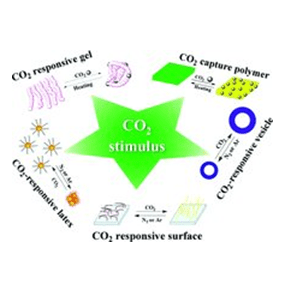Stimuli-responsive polymers can react to a certain stimulus with high selectivity. A change in light, temperature or pH triggers a reaction which affects at least one physicochemical property of the responsive component.
In highly sensitive syste ms or under in-vivo conditions the stimulus should ideally have a highly predictable effect and potential side-effects or reactions should be avoided. CO2 can be considered as a kind of “green trigger” and plays an important role as an endogenous metabolite. It is therefore an attractive stimulus for polymeric bioapplications e.g. in drug or gene delivery.
ms or under in-vivo conditions the stimulus should ideally have a highly predictable effect and potential side-effects or reactions should be avoided. CO2 can be considered as a kind of “green trigger” and plays an important role as an endogenous metabolite. It is therefore an attractive stimulus for polymeric bioapplications e.g. in drug or gene delivery.
Another appealing feature of CO2-reponsive polymeric materials is their ability to capture CO2. The gas is currently the main contributor among all anthropogenic greenhouse gases which amplify the natural greenhouse effect and lead to global warming. In the past years, there has been increasing interest in possibilities to capture CO2 from the atmosphere and ensure a safe storage.
In their Review Article “CO2-Responsive Polymers”, Theato and coworkers give a timely overview of recent progress in the field of CO2-responsive polymers. The polymer materials are categorized by their three different active functional groups, their structures and their use as CO2-responsive or absorbing materials. Finally, they provide a detailed discussion about the challenging aspects of ongoing research activities and the prospects of this exciting class of smart polymer materials.
This article is part of the special Best of Macros 2013 issue, and is now free to read at http://www.best-of-macros.de!

















